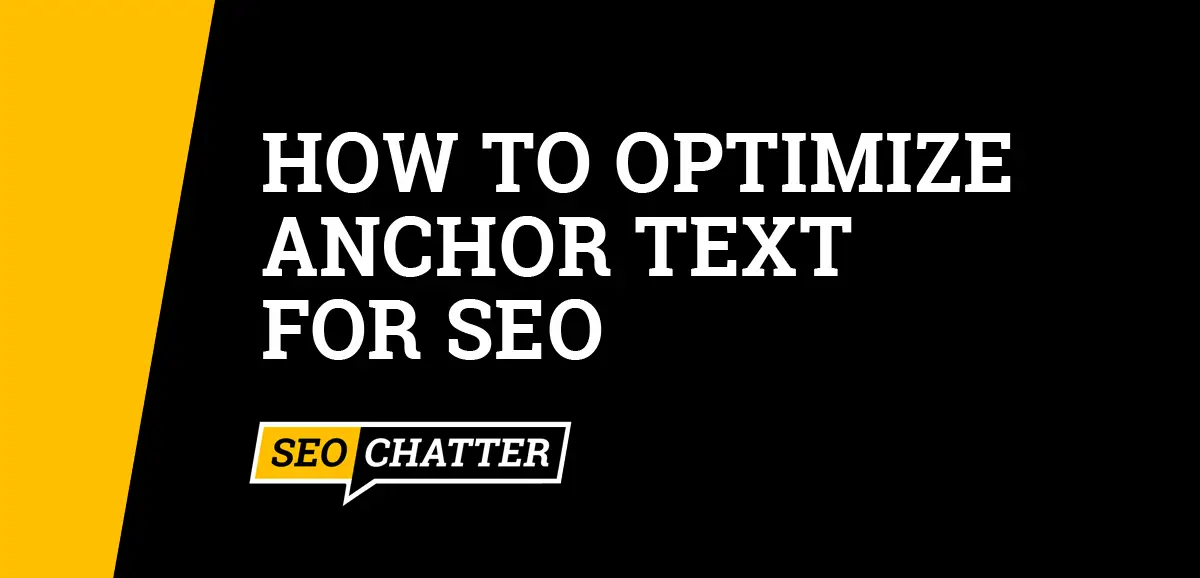This search engine optimization (SEO) guide explains how to optimize anchor text for SEO.
Below, you’ll find a list of the top anchor text optimization tips you can use to improve the rankings and traffic for your website based on anchor text best practices in digital marketing (for both internal links and backlinks).
There’s also a section with additional resources that explain more about the fundamentals of anchor text to help you create a better search engine optimization strategy.

How to Optimize Anchor Text for SEO
1. Choose 3-4 Keywords for SEO
The first way for how to optimize anchor text in SEO is to choose 3-4 keywords to target for a specific web page. These search terms should be the same keywords the target page is optimized for with on-page SEO (i.e., the main keyword phrase and several close variations).
This method allows you to create a better optimization strategy for both the internal links you place on the site and the backlinks you obtain through link building as explained throughout the rest of this guide.
2. Optimize for the Main SEO Keyword First
Another best practice for anchor text optimization is to optimize for the main SEO keyword first because you want the strongest ranking signals for that key phrase.
Typically, the main keyword should be the term that receives the highest average monthly search volume while the secondary terms are used to pick up extra search traffic from relevant queries and to strengthen topical relevance for the linked content.
Tips 8 and 9 below will help you set up the proper anchor text ratios for internal links and backlinks using the target SEO phrases you’ve selected.
3. Keep Anchor Text Short
Keeping the descriptive text short is a good way to optimize anchor text for search engine optimization because it strengthens the relevancy signals of the clickable text for indexing and ranking.
In fact, Google’s search engine crawler will typically ignore words in the anchor text after a certain length. Therefore, a best practice for SEO is to make your anchor text 8 words or less (around 55-60 characters) to get the maximum value for search engine optimization.
4. Pick One Anchor Text for the Content
Next up in this list of anchor text optimization tips is to only pick one anchor text phrase to use on the page for a target URL. Then, never vary from it.
This SEO technique applies to both internal links that are placed inside an article and backlinks that are created through link building to a target web page.
If a search engine crawler discovers more than one hyperlink on a page leading to the same URL, and those links have different descriptive text, then the indexing and ranking algorithms can get confused as to which anchor text is the most accurate to use for SEO.
Therefore, whatever you choose as the clickable text for the first anchor text link that appears on the page, should also be used as the same clickable text when you want to link to the same URL again inside the article. In other words, pick one anchor text and stick with it throughout the content.
5. Never Use the Same SEO Anchor for Other Pages
If you want to optimize your anchor text for better search engine optimization in the best possible way, you should never use the same anchor text for different URLs on the same website.
This is a common mistake that many beginner SEOs make that often causes significant keyword ranking issues throughout the site. That’s because the search engine crawlers get confused as to which URL should be correctly indexed and ranked for a particular keyword phrase when more than one web page has incoming links using that key phrase.
A good practice to follow for well-optimized anchor text is to keep a log of the 3-4 SEO keywords you chose in step 1 above for the target page. That way, you know not to use those terms for any other URL on your site.
Then, before you create a new internal link for on-site SEO or perform outreach during a link building campaign, you can verify that the page you’re building links to has not been assigned the same keyword as another page.
6. Accurately Describe the Target Page
Accurately describing the target page is another top way to optimize anchor text for SEO and to increase the chances of users actually clicking on the link to increase traffic to important content.
What this means in practice is explaining to the user what they can expect to find on the destination page of the link instead of just hyperlinking random text in the content for SEO purposes only. Without adding important context around the clickable text, the user may not understand the importance of why they should click on the anchor text.
When you’re optimizing anchor text for SEO, you should also take a few extra moments to optimize the sentence before the link with a call to action to encourage visitors to actually click on the anchor text to visit the target page.
7. Surround Anchor Text with Relevant Keywords
Following up on tip 6 above, another anchor text best practice is to surround the clickable text with other associated keywords and semantically related words. This is especially true if you’re creating a partial match, phrase match, or natural anchor text link as mentioned in tips 8 and 9 below.
This is an important concept to understand for SEO because Google’s algorithm will analyze the surrounding text of a backlink and use it to help index the target URL for appropriate keywords. The technical term used in Google’s ranking patents for this process is “annotation text”, which has been documented as a ranking signal by search engine optimization experts like the late Bill Slawski.
8. Use Good Internal Anchor Text Optimization
One of the easiest ways to improve your website’s rankings in the search engine results pages (SERPs) is to use a good internal anchor text optimization strategy.
SEO scientist Kyle Roof discovered through testing that it takes about 3-4 internal links to equal the strength of one backlink on average. And Matt Diggity, another popular SEO expert, found that over-optimizing your anchor texts with too many exact match keyword phrases can cause a ranking penalty.
After years of my own trial and error based on those two experts’ advice, I’ve developed an effective—and safe—way of creating optimized internal links with descriptive anchor text that benefits on-site SEO while also avoiding any link manipulation penalty by the search engine algorithms.
A good anchor text ratio to follow for internal links includes:
- 60% Phrase Match Anchors: The clickable text includes a few words before or after the exact match keyword phrase to reduce over-optimization.
- 30% Exact Match Anchors: The clickable link includes the exact match keyword and nothing else.
- 10% Partial Match Keywords and Variations: The clickable text includes only a portion of the target keyword phrase (e.g., drop a word or two) or a variation of the main keyword (e.g., a reordering of the words or swapping out common words with synonyms).
9. Keep a Natural Backlink Anchor Text Ratio
If you’re doing active link building for your website, then your anchor text will be better optimized for SEO while also reducing the chances of your backlinks being detected as link manipulation by the search engine algorithms if you follow these anchor text optimization best practices below for the homepage and inner pages.
Homepage Backlinks Anchor Text Ratio
- 80-95% mix of branded, natural, and URL anchor text.
- Up to 10% with partial and phrase match keywords included in anchor text.
- Up to 5% with exact match keyword anchor text.
Inner Page Backlinks Anchor Text Ratio
- 35-45% mix of branded, natural, and URL anchor text.
- 50-60% with partial and phrase match keywords included in anchor text.
- Up to 10% with exact match keyword anchor text.
10. Make Sure Anchor Text Links Are Dofollow
A final way for optimizing anchor text for search engine optimization is to make sure your hyperlinks are dofollow links. Otherwise, search engine crawlers may ignore the target keyword in the clickable text and the PageRank signals for SEO.
Unless you tag your internal links with the nofollow attribute, those links should be dofollow. However, the backlinks you build may or may not be dofollow—every website is different with its own guidelines for outbound links.
Nofollow links are coded with the rel=nofollow HTML tag to tell search engines not to pass any PageRank (or link juice) from the original web page to the target page. This is how you can control which web pages on the Internet get credit for the backlinks coming from your website as well as which internal links receive the flow of incoming link juice for SEO.
Note: In 2019, Google announced that the nofollow link attribute would be seen as a hint rather than a directive for backlinks. That means nofollow links may or may not pass PageRank value to the target web page; however, it’s still not worth the chance to dilute the power of internal or inbound links if you can control this HTML attribute.
Optimize Anchor Text In SEO Best Practices Summary
I hope you enjoyed this guide explaining how to optimize anchor text in SEO.
As you discovered, there are many anchor text optimization tips you can follow to improve your website’s search engine optimization, with the top anchor text best practices including choosing 3-4 keywords for SEO, keeping anchor text short, picking one anchor text for the content, surrounding the hyperlink with other relevant keywords, using a good anchor text distribution, and more. Following these guidelines can help improve your overall SEO strategy for higher rankings and traffic.

SEO Chatter is dedicated to teaching the fundamentals of search engine marketing to help marketers understand how to increase organic website traffic and improve search engine rankings.
